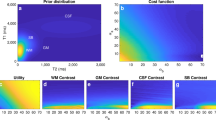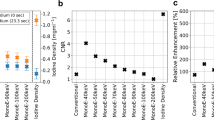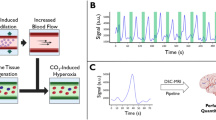Abstract
Cardiovascular disease is primarily diagnosed using invasive X-ray cineangiography. Here we introduce a new concept in magnetic resonance imaging (MRI) that, for the first time, produces similar images noninvasively and without a contrast agent. Protons in moving blood are 'tagged' every few milliseconds as they travel through an arbitrary region in space. Simultaneous with ongoing tagging of new blood, previously tagged blood is maintained in a state of global coherent free precession (GCFP), which allows acquisition of consecutive movie frames as the heart pushes blood through the vascular bed. Body tissue surrounding the moving blood is never excited and therefore remains invisible. In 18 subjects, pulsating blood could be seen flowing through three-dimensional (3D) space for distances of up to 16 cm outside the stationary excitation region. These data underscore that our approach noninvasively characterizes both anatomy and blood flow in a manner directly analogous to invasive procedures.
This is a preview of subscription content, access via your institution
Access options
Subscribe to this journal
Receive 12 print issues and online access
$209.00 per year
only $17.42 per issue
Buy this article
- Purchase on Springer Link
- Instant access to full article PDF
Prices may be subject to local taxes which are calculated during checkout





Similar content being viewed by others
References
Heart disease and stroke statistics—2003 update (American Heart Association, Dallas, 2003).
Popovic, J.R. 1999 National Hospital Discharge Survey: annual summary with detailed diagnosis and procedure data. National Center for Health Statistics. Vital Health Stat. 13, 1–206 (2001).
Aspelin, P. et al. Nephrotoxic effects in high-risk patients undergoing angiography. N. Engl. J. Med. 348, 491–499 (2003).
Topol, E.J. & Nissen, S.E. Our preoccupation with coronary luminology. The dissociation between clinical and angiographic findings in ischemic heart disease. Circulation 92, 2333–2342 (1995).
Nieman, K. et al. Reliable noninvasive coronary angiography with fast submillimeter multislice spiral computed tomography. Circulation 106, 2051–2054 (2002).
Ropers, D. et al. Detection of coronary artery stenoses with thin-slice multi-detector row spiral computed tomography and multiplanar reconstruction. Circulation 107, 664–666 (2003).
Schroeder, S. et al. Noninvasive detection and evaluation of atherosclerotic coronary plaques with multislice computed tomography. J. Am. Coll. Cardiol. 37, 1430–1435 (2001).
Schoenhagen, P. et al. Non-invasive assessment of plaque morphology and remodeling in mildly stenotic coronary segments: comparison of 16-slice computed tomography and intravascular ultrasound. Coron. Artery Dis. 14, 459–462 (2003).
Achenbach, S. et al. Detection of calcified and noncalcified coronary atherosclerotic plaque by contrast-enhanced, submillimeter multidetector spiral computed tomography: a segment-based comparison with intravascular ultrasound. Circulation 109, 14–17 (2004).
Achenbach, S., Moshage, W., Ropers, D., Nossen, J. & Daniel, W.G. Value of electron-beam computed tomography for the noninvasive detection of high-grade coronary-artery stenoses and occlusions. N. Engl. J. Med. 339, 1964–1971 (1998).
Hademenos, G.J. & Massoud, T.F. Biophysical mechanisms of stroke. Stroke 28, 2067–2077 (1997).
Shibata, M. et al. Assessment of coronary flow reserve with fast cine phase contrast magnetic resonance imaging: comparison with measurement by Doppler guide wire. J. Magn. Reson. Imaging 10, 563–568 (1999).
Waggoner, A.D. & Bierig, S.M. Tissue Doppler imaging: a useful echocardiographic method for the cardiac sonographer to assess systolic and diastolic ventricular function. J. Am. Soc. Echocardiogr. 14, 1143–1152 (2001).
Feinberg, D.A., Crooks, L., Hoenninger, J., 3rd, Arakawa, M. & Watts, J. Pulsatile blood velocity in human arteries displayed by magnetic resonance imaging. Radiology 153, 177–180 (1984).
Wedeen, V.J. et al. Projective imaging of pulsatile flow with magnetic resonance. Science 230, 946–948 (1985).
Dixon, W.T., Du, L.N., Faul, D.D., Gado, M. & Rossnick, S. Projection angiograms of blood labeled by adiabatic fast passage. Magn. Reson. Med. 3, 454–462 (1986).
Nishimura, D.G., Macovski, A., Pauly, J.M. & Conolly, S.M. MR angiography by selective inversion recovery. Magn. Reson. Med. 4, 193–202 (1987).
Singer, J.R. & Crooks, L.E. Nuclear magnetic resonance blood flow measurements in the human brain. Science 221, 654–656 (1983).
Reeder, S.B., Atalay, M.K., McVeigh, E.R., Zerhouni, E.A. & Forder, J.R. Quantitative cardiac perfusion: a noninvasive spin-labeling method that exploits coronary vessel geometry. Radiology 200, 177–184 (1996).
Edelman, R.R. et al. Signal targeting with alternating radiofrequency (STAR) sequences: application to MR angiography. Magn. Reson. Med. 31, 233–238 (1994).
Stuber, M., Bornert, P., Spuentrup, E., Botnar, R.M. & Manning, W.J. Selective three-dimensional visualization of the coronary arterial lumen using arterial spin tagging. Magn. Reson. Med. 47, 322–329 (2002).
Axel, L., Shimakawa, A. & McFall, J. A Time-of-flight method of measuring flow velocity by magnetic resonance imaging. Magn. Reson. Imaging 4, 199–205 (1986).
Spuentrup, E. et al. Renal arteries: navigator-gated balanced fast field-echo projection MR angiography with aortic spin labeling: initial experience. Radiology 225, 589–596 (2002).
Liang, Z.P. & Lauterbur, P.C. Signal characteristics. in Principles of Magnetic Resonance Imaging (ed. Akay, M.) chap. 4 (Willey-IEEE Press, Piscataway, New Jersey, 1999).
Stefansic, J.D. & Paschal, C.B. Effects of acceleration, jerk, and field inhomogeneities on vessel positions in magnetic resonance angiography. Magn. Reson. Med. 40, 261–271 (1998).
Frank, L.R., Crawley, A.P. & Buxton, R.B. Elimination of oblique flow artifacts in magnetic resonance imaging. Magn. Reson. Med. 25, 299–307 (1992).
Simonetti, O.P., Wendt, R.E. & Duerk, J.L. Significance of the point of expansion in interpretation of gradient moments and motion sensitivity. J. Magn. Reson. Imaging 1, 569–577 (1991).
Nishimura, D.G., Irarrazabal, P. & Meyer, C.H. A velocity k-space analysis of flow effects in echo-planar and spiral imaging. Magn. Reson. Med. 33, 549–556 (1995).
Oppelt, A. et al. FISP: eine neue schnelle Pulssequenz für die Kernspintomographie. Electromedica 54, 15–18 (1986).
Manginas, A. et al. Estimation of coronary flow reserve using the thrombolysis in myocardial infarction (TIMI) frame count method. Am. J. Cardiol. 83, 1562–1565 (1999).
Acknowledgements
The authors thank R. Johnson for his help with the experimental preparation and O.P. Simonetti for helpful discussions.
Author information
Authors and Affiliations
Corresponding author
Ethics declarations
Competing interests
W.G.R. is an employee of Siemens Medical Systems, which manufactures MRI scanners. R.M.J., E.L.C. and R.J.K. are inventors on a related, pending US patent.
Supplementary information
Rights and permissions
About this article
Cite this article
Rehwald, W., Chen, EL., Kim, R. et al. Noninvasive cineangiography by magnetic resonance global coherent free precession. Nat Med 10, 545–549 (2004). https://doi.org/10.1038/nm1027
Received:
Accepted:
Published:
Issue Date:
DOI: https://doi.org/10.1038/nm1027
This article is cited by
-
Ultrafast Doppler Reveals the Mapping of Cerebral Vascular Resistivity in Neonates
Journal of Cerebral Blood Flow & Metabolism (2014)



